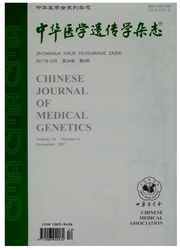

 中文摘要:
中文摘要:
目的 探讨确诊为PMP22大片段重复突变腓骨肌萎缩症(CMT)患者的临床特点。方法 在近年来所搜集的65个CMT家系中,用实时荧光定量PCR确诊出18个PMP22大片段重复突变的家系,对这些家系的临床特点进行回顾性分析。结果 18个被确诊为PMP22大片段重复突变CMT家系患者中,发病年龄10~56岁,平均年龄16.6岁,病程3~26年,平均14.1年,首发症状为双下肢肌肉萎缩伴乏力者最为常见,占88.9%,所有患者均存在不同程度的双下肢萎缩,双上肢无力伴萎缩9例,占50%,跨阈步态8例,占44.4%,弓形足畸形1(0例,占55.6%,双下肢感觉减退7例,占38.9%,双上肢感觉障碍3例,占16.7%,颅神经损害罕见;肌电图检查15例出现纤颤电位,16例出现运动单位时限延长,神经传导速度(NCV)检查:15例NCV速度减慢,平均正中神经传导速度为(25.68±7.6)m/s;病理检查显示15例神经纤维间结缔组织增生,有髓纤维数目减少,14例患者可见洋葱球样改变。结论 本病临床特点与国外文献报道非常相似,大多于青少年期起病,均以肢体远端无力与萎缩,骨骼畸形为主要表现,感觉障碍较国外患者常见;电生理改变以纤颤电位和运动单位时限延长为主,病理改变以神经纤维结缔组织增生、有髓纤维数目减少和洋葱球样改变多见。
 英文摘要:
英文摘要:
Objective To analyze the clinical features of CMT patients with PMP22 duplication. Methods We collected 65 CMT families in which there were 18 families with PMP22 duplication by using real-time quantitative PCR, then analyzed their clinlical features. Results In these patients, the age of onset ranged from 10 - 56 years old,and the average was 16.6 years. The course of disease ranged from 3 - 26 years, and the average was 14. 1 years. The most frequently first symptom was weakness and atrophy in lower limbs, accounting for 88. 9%. Atrophy in lower limbs was common in all patients. 9 patients showed weakness and atrophy in upper limbs, accounting for 50%;8 patients had drop-foot gaits(44. 4% ), 10 patients had Talipes cavus(55.6% ), 7 patients had hypesthesia in lower limbs (38.9%) ;3 patients had hypesthesia in upper limbs (16. 7% ) cranial nerve lesions in all patients were rare. Electromyogram and nerve conduction velocity showed that fibrillation potential in 15 patients,prolonged time limit of motor unit in 16 patients, demonstrated slow nerve conduction velocities in 15 patients. The average conduction velocity of median nerve was 25.68± 7. 6m/s. Pathological examination showed desmoplasia among neurofibras and decreased myelinated nerve fibers in 15 patients;and onionskin change in 14 patients. Conclusions The clinical features of the CMT patients with PMP22 duplication are similar to those reported previously. Most patients'age of onset is adolescent, with weakness and atrophy in lower limbs and skeletal deformity. Sensory disability was more frequent than that in European and Brazil patients. Electrophysiological and pathological examination showed extensive demyelination changes in peripheral nerve.
 同期刊论文项目
同期刊论文项目
 同项目期刊论文
同项目期刊论文
 期刊信息
期刊信息
